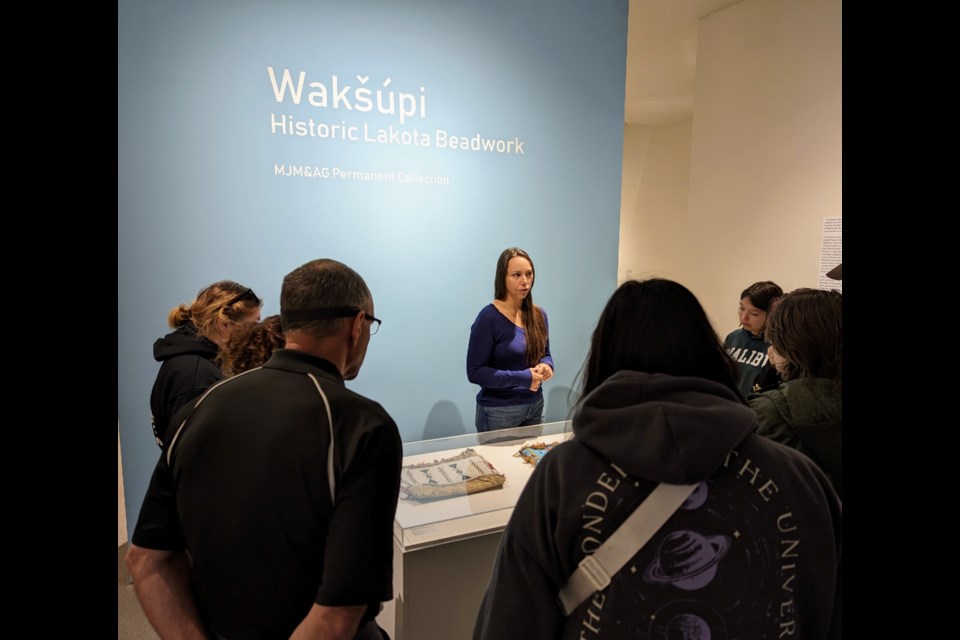Students from Moose Jaw and district schools received the unique opportunity on Nov. 1 and 2 for personal guided tours from Dr. Claire Thomson, who curated Wakšúpi: Lakota Beadwork, currently on display at the Moose Jaw Museum & Art Gallery (MJMAG).
Dr. Thomson, a Lakota woman from the Wood Mountain area, defended her Ph.D dissertation, “Digging Roots and Remembering Relatives: Lakota Kinship and Movement in the Northern Great Plains from the Wood Mountain Uplands Across Lakota Thamakhoche/Lakota Country, 1881-1940,” at the University of Alberta in 2022. She received the Governor General's Gold Medal in recognition of her outstanding academic achievement.
She is also a field historian with Parks Canada, volunteer secretary for the Wood Mountain Historical Society, and earned bachelor's and master's degrees from the University of Saskatchewan.
Her background makes her one of the world's leading historians on Lakota history, culture, and artifacts from the southern prairies and the Wood Mountain area in particular.
"I'm very grateful to have been asked to curate this exhibit and it's great to have it, but it's also important to do outreach and connect with the community and especially with young people, so when the museum and art gallery asked me to come down for this, I said, 'Of course,'" Thomson said. "I am used to school tours, as a board member at the Wood Mountain Rodeo Ranch Museum. We do a lot of them.
"It's important to get young folks out for activities like these because learning about the history of Moose Jaw, and especially of Lakota people's connections to the land and history, is something you can't necessarily get through curriculum alone. It's really specific to place. ... I do like doing these tours, especially when you get those students you can see are really interested and ask questions and engage. I always find that interesting."
The Wakšúpi exhibit pieces are from the MJMAG's Permanent Collection, which Thomson has been involved with for years (one rare pre-1900 photograph includes her great-great-grandmother.) There are quillworks, the precursor to beadwork, which came with European trade; incredibly intricate and valuable works of art made for family and ceremonial use; practical, yet decorated artworks such as knife sheaths and satchels; and historic photos from Moose Jaw's early days.
Collections of Indigenous artifacts have been accumulated all over the world, Thomson said. Many of them are enormous — and uncatalogued. Thomson has been able to clarify the origins, use, and meaning of many of the MJMAG's Lakota pieces, and shared her passion for her work with students on the tour.
"There are collections like these in museums and private collections all around the world, and most of the time, they don't have any labels about who made them or even what culture made them," Thomson told students. Pointing at a beadwork display case, she explained, "These ones were all labelled, at one time, as just 'Sioux', which is not actually a Lakota or Dakota term, so it was unclear who actually made them."
Sharol Sommerville, a student support worker at Phoenix Academy, said experiences like these are important for students to fully understand Canadian and pre-Canadian history. They also provide the groundwork for productive discussions during regular curriculum times.
"We speak about being on Treaty Four land, but what does that actually mean to students?" Sommerville noted. "Being part of this, seeing what our community can do and what our curator here today has done, it brings the past into our reality now and gives them an opportunity to have experiential, land-based learning, as opposed to just reading it in a book."
"I wasn't aware even Moose Jaw, alone, had this big of an Indigenous collection," said Reese Gilbert, a Grade 12 student at Phoenix Academy. "It's really just fascinating that we have all this history that most people aren't even aware of. It's a little sad that a lot of the people who made these probably don't even have family who know it's here anymore, but it's still good to see that its being appreciated.
"There were people here for hundreds and thousands of years, so it's crazy that there are people who were born and raised here who don't even know these cultures existed. They had their own lives and all we see is what's left that we've collected. It's like looking through a mirror to the other side and seeing, you know, how things could have been if it had gone differently."
In response to some providers blocking access to Canadian news on their platforms, our website, MooseJawToday.com will continue to be your source for hyper-local Moose Jaw news. Bookmark MooseJawToday.com and sign up for our free online newsletter to read the latest local developments.




